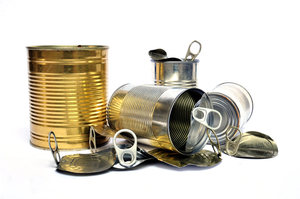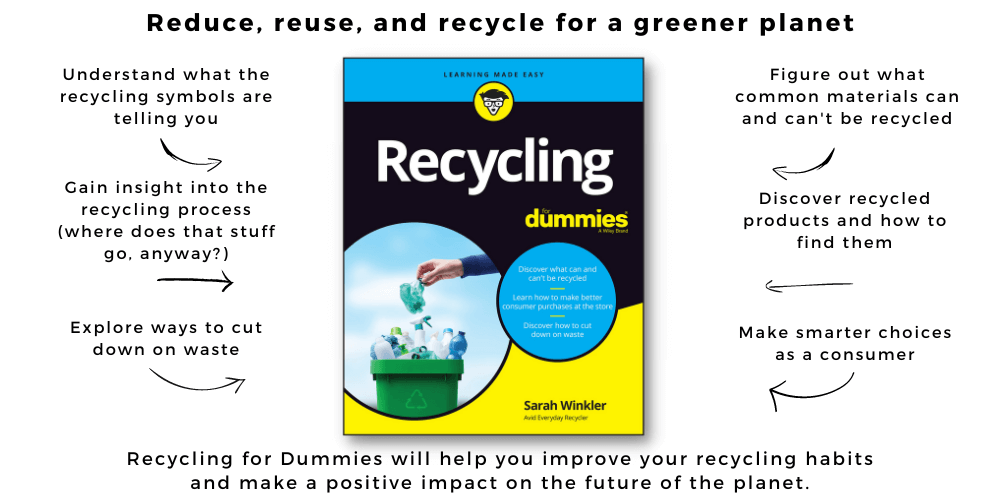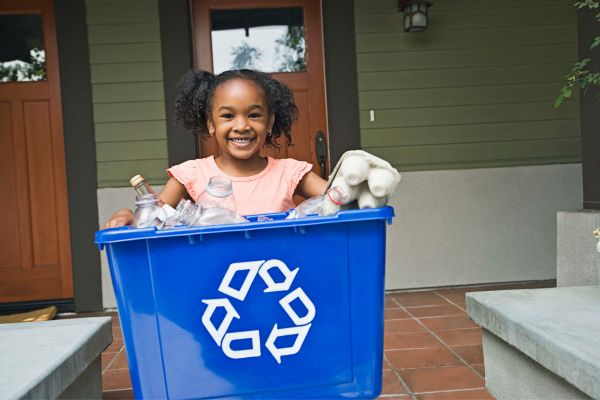WHAT IS RECYCLING AND WHY IS IT IMPORTANT
I’m sure most of you know what recycling is, but before we learn how to recycle at home, it’s always good to go over the basics and remember why we do it. So first, we’re going back to basics to discuss what recycling is and why it’s important.
Recycling is the process of converting waste materials into new goods. This definition makes it all sound pretty straightforward, but in most cases, there are multiple steps involved in taking an item that’s placed in your recycling bin, say a plastic water bottle, and turning it into a new product like a pair of leggings or a new water bottle.
In order to recycle an item, first it must be collected, then sorted. Multiple types of sorting can occur depending on what material is collected and how much it is already separated. Then it must be cleaned, crushed or flaked, and baled (bundled up so that it can be transported). Hopefully, it can then be sold to a manufacturer who may further sort and clean the material before using it in a new product.
The collection is where you and I fit in. One of the common ways material is collected for recycling is through a curbside collection service. Curbside services are where we are provided with one or more bins, either via our local government or a private company, then we put items into the bins, and they are picked up from our home.
Curbside recycling, as we know it, started up during the 1980s. Before this, there were various smaller versions of curbside collection for different waste materials but not specifically for recycling. That means curbside recycling has only been around for 30ish years. It’s quite a young system, but then consider how much has changed in those 30 years. Not only has the population increased, but there have been rapid changes in consumption patterns and significant advancements in packaging materials. Curbside systems must devote an enormous amount of effort to keep up with these changes and developments.
Why is recycling important?
I’m sure you are aware of the terrible rate at which trash is being produced worldwide. As individuals, we create, on average, 3.5 pounds of trash every day. At a global level, that’s more than 2 billion tons of trash every year, and it’s not slowing down any time soon. In fact, it’s expected to continue to increase across all regions, as demonstrated by the graph below.
The largest increase in waste production is anticipated to occur in regions with high proportions of growing low-income and lower-middle-income countries, like Sub-Saharan Africa and South Asia regions. However, it is still predicted that waste levels will grow in higher-income countries like North America, Europe, and Central Asia.
Waste is a problem for everyone on the planet!
What are the benefits of recycling?
Recycling is important because it’s an action we can take right now to help the situation. It has a real and immediate impact in reducing the amount of waste that goes to landfill and ensuring that materials are collected and made into new products. These two things, in turn, help reduce the impact on our planet’s environment.
The most obvious benefit of recycling is that it saves materials from landfill or incineration. These activities each have their own negative impacts on our planet and human health, so we should avoid them as much as possible.
Recycling also reuses materials that we already have. Extracting and obtaining new materials to manufacture products from scratch has many negative consequences on the planet. Mining minerals or harvesting trees, for example, directly impacts the environment but also involves a great deal of energy use and greenhouse gas emissions. If recycling can help to reduce the amount of raw materials we use globally, that’s a huge positive.
Here is a summary of the benefits of recycling:
- Recycling reduces waste sent to landfill
- Recycling saves energy and resources
- Recycling helps protect the environment
- Recycling helps combat climate change
- Recycling conserves natural resources
- Recycling creates a more sustainable industry
- Supports the circular economy
- Recycling helps keep our waterways and oceans clean
- Minimise impacts on animals
- Prevents loss of biodiversity
- Enhances Community Cohesion
You can explore these benefits in more detail by reading about the benefits of recycling.
Redefining what curbside recycling is
The best way to break any bad habits you may have is to rethink curbside recycling completely.
Curbside recycling was primarily designed to collect excess packaging from households, and back when it was developed, this mostly consisted of paper, glass, plastic, and metals. Unless otherwise instructed, sticking to these four categories, paper, glass, metal, and plastic, helps simplify things quite a bit.
The second thing that helps is to consider that it’s primarily designed to collect packaging. That means glass bottles, glass jars, tin cans, cardboard boxes, or plastic packaging. Almost immediately, it helps to rule out a whole bunch of stuff that we wish could be recycled.
When we understand these limitations, it helps us to understand why many things are not accepted by curbside recycling. Issues can arise when we place these incorrect items in our recycling bins. This is because it’s not designed to work with some of those types of materials. For example, your curbside recycling bin is not the proper place for clothing. Material recovery facilities are not designed to handle clothing or textiles, so it can cause issues with the machinery at the facility.
The following is a condensed version of the general guidelines for many curbside recycling systems. Over the coming lessons, we will look into each one of these categories in more detail to help you learn how to recycle at home.
Paper and cardboard
All curbside services usually accept paper and include items like printing paper, magazines, newspapers and catalogs, cardboard boxes, and paperboard boxes. We will discuss paper and cardboard in more detail in Lesson 7.

Rigid plastic
Rigid plastics are those that cannot be scrunched up into a ball. They include things like milk bottles or shampoo bottles. Most curbside recycling services only accept rigid plastics, and many only accept certain types of plastics. We will learn lots more about that in Lesson 9.

Metal
Although most metals are highly recyclable curbside services generally only accept cans, tins, and aluminum foil. Most other metal items must be disposed of at a metal scrapyard. Find out more in Lesson 8.

Glass
Glass is only accepted in some locations, and there are some good reasons for this. If glass is collected in your area, only glass bottles and jars are usually accepted. I will explain the reason why it’s often not accepted and discuss what sort of glass can be recycled in Lesson 6.
Please note that many curbside programs don’t collect glass (but more on later). Plus, some collect other types of materials than those listed above. These differences in how and what is accepted are why checking with your local authority is always important and you will hear me saying it throughout this challenge.

TASK
Take a moment to consider why recycling is important to you. Is it because you are concerned about your children’s future, or do you want to lower your impact on the planet? Jump on and share your thoughts in our Facebook Group or feel free to send an email and share them with the team at Everyday Recycler.
SUGGESTED READING
In Lesson 2, to help you on your journey to learn how to recycle at home, I will show you how to find your local rules, and then we’ll go through the most critical items to look for.
Let’s conquer curbside recycling together!
You can jump to any of the other lessons below:
- Conquer Curbside Recycling Challenge Page
- Lesson 1 – WHAT IS RECYCLING AND WHY IS IT IMPORTANT
- Lesson 2 – FINDING YOUR RECYCLING RULES
- Lesson 3 – RECYCLING CODES AND SYMBOLS
- Lesson 4 – REDUCING CURBSIDE RECYCLING CONTAMINATION
- Lesson 5 – GETTING FAMILIAR WITH SOME COMMON RULES
- Lesson 6 – RECYCLING GLASS IN CURBSIDE BINS
- Lesson 7 – RECYCLING PAPER IN CURBSIDE BINS
- Lesson 8 – RECYCLING METAL IN CURBSIDE BINS
- Lesson 9 – RECYCLING PLASTIC IN CURBSIDE BINS
- Lesson 10 – RECYCLING CURBSIDE BINS OVERVIEW
If you liked this challenge, then you are definitely going to like my book “Recycling for dummies”. It has 384 pages filled with knowledgeable and actionable content for you to become a better recycler. Find out more here.















